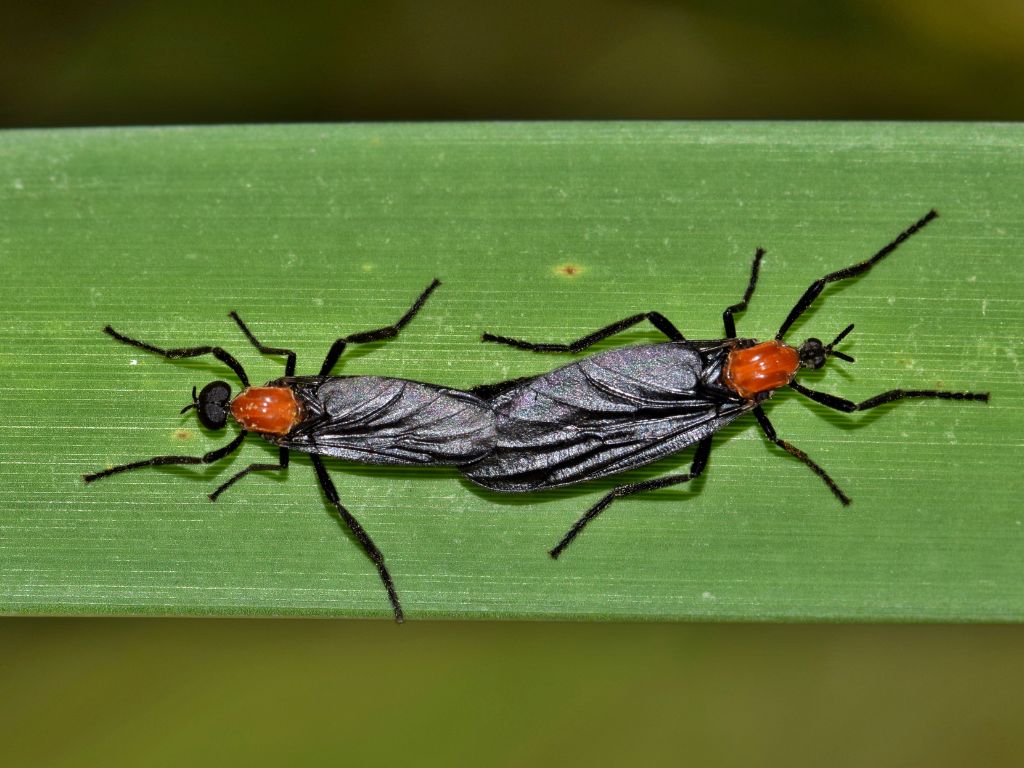Interesting facts about Love Bugs and their role in the ecosystem
Changes in the life cycle of Love Bugs alarm the ecologists
The cool (winter) season is love bug season! These bugs (though they’re flies, not bugs) herald seasonal changes and are the harbinger of a colder season.
If you are an entomology buff, you might wonder:
What is this abrupt advent of teeny-weeny black creatures with bright orangish thorax lying all around in Doon Valley, Uttarakhand (India)?

Love bag information – Classification, Description, and physiology
The scientific name of this swarm of flies is Plecia indica (Brunetti, 1911). The species is classified to the family Bibionidae of the order Diptera (two-winged flies). They are addressed as love bugs or honeymoon flies because males and females remain united back-to-back during mating, even in flight. The pair will stay in this tandem position for several days long after mating.
- Description: Dark translucent wings, long black legs, and short antennae. Females are generally larger and have narrow, elongated heads, whereas males are smaller and have rounded heads. The adult body shows varying degrees of hairiness and measures 5 to 12 mm. So far, 29 species from four genera of the family Bibionidae have been reported from the Indian Himalayas (Chandra et al., 2018).
- Life Cycle: Love bugs usually have a life span of six months and hence have two generations per year. They lay eggs either in spring (April-June) or fall (August-October) and develop into adults. After mating, the males die and are dragged around by the females until they lay the eggs. Each female lays up to 100–350 eggs, and larvae feed on decaying plants. As an adult, love bugs live only a few weeks.
- Habitat and Food Source: The juveniles and larvae enjoy leaf litter and decomposed organic debris in a variety of terrestrial and aquatic settings. Large swarms of adults can be frequently sighted in terrestrial habitats near meadows, grassy hillsides, or decaying vegetation. They feed on the nectar of flowers and are relatively short-lived. Larvae feed gregariously on the roots and tubers of various crops.
Benefits and threats of Love Bugs in natural and Agricultural Ecosystems
Ecological function: They serve two key ecological functions: decomposition and pollination. They feed on the pollen and nectar of flowering plants and pollinate in the process. Despite these negative effects, flies are valuable decomposers, parasitoids, pollinators, food for birds and larger insects, and bio-indicators of water quality and ecosystem health (Courtney et al., 2009). They provide crucial ecosystem services such as biodegradation and natural recycling of organic materials. Several medicinal plants, crops, and meadow flowers depend on dipterans for pollination, and the loss of flies in particular regions would result in the extinction of the flora and vice-versa.
Pest Status: Large swarms of flies are a nuisance, but they are not considered pests. They are harmless, do not bite or sting, and are non-poisonous beings.
Threats: Most love bugs are sighted during September (in early fall), but for the last 3-5 years, they have been making late appearances, which may be a matter of concern. Ecologists attribute these delayed emergences primarily to anthropogenic activities and environmental changes such as habitat loss, pollution, indiscriminate use of pesticides, and climate change, all of which disrupt the phenology of late floral blooming and eventually affect the behavioral ecology of the insects. It may also affect their mating patterns, navigation, and interactions with other species in the ecosystem.
Conservational Efforts: Considering the threats they face, we must act to ensure their conservation. These tiny mini-creatures can be protected through encouraging organic farming, safeguarding their habitat, biodiversity monitoring, pollution control, collaboration with citizen scientists, etc.
Reference
Brunetti, E. 1911. New Oriental Nematocera. Records of the Indian Museum 4: 259-316. [1911.06.07]
Chandra, K., Gupta, D., Gopi, K. C., Tripathy, B., & Kumar, V. (2018). Faunal Diversity of Indian Himalaya: 1-872. (Published by the Director, Zool. Surv. India, Kolkata). Published: March.
Courtney, G.W., Pape, T., Skevington, J.H., Sinclair, B.J., 2009. Chapter 9: Biodiversity of Diptera. In: Foottit, R.G., Adler, P.H. (Eds.), Insect Biodiversity: Science and Society. Blackwell Publishing, Oxford, pp. 185–222.











































































